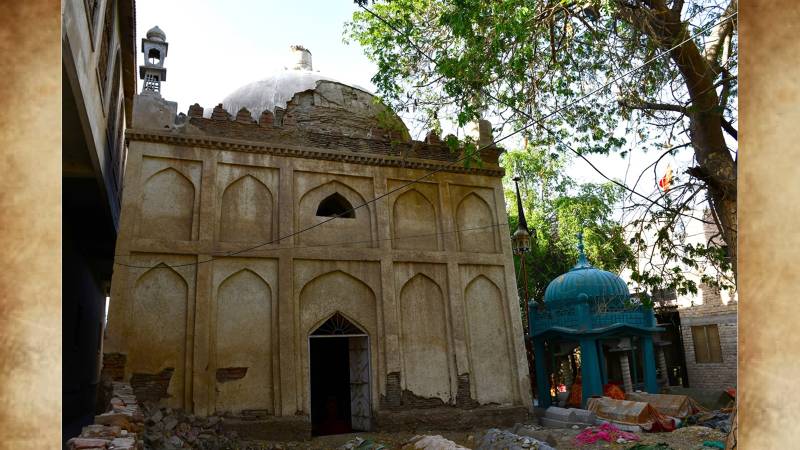
Shikarpur is home to several historical tombs, found not only within the city but also in various villages and towns throughout the district. Most of these tombs were constructed during the 18th, 19th, and 20th centuries. The oldest tomb in Shikarpur is the mausoleum of Syed Mehar Shah Ghazi, the town's earliest mystic. There are two versions of the story regarding Syed Mehar Shah Ghazi's arrival in Shikarpur. One version suggests that one of his ancestors settled there, while the other states that his father, Syed Noor Muhammad, was the first member of the family of Makhdoom Fazal al-Din to migrate from Uch to Shikarpur.
Professor Amin Alavi (1984:104-5) was probably the first scholar from Shikarpur who briefly mentioned Syed Mehar Shah Ghazi in his article “Shikarpur Ja Sufia Karam," which was published in Shikarpur Mazi Ain Haal (Shikarpur: Past and Present), a book compiled by Dr Memon Abdul Majeed Sindhi. This was the seminal article on the Sufis saints of Shikarpur. One learns from Professor Amin Alavi’s article that Shikarpur was then a small settlement or hunting ground (shikargah) when the father of Syed Mehar Shah Ghazi came to Shikarpur. Syed Noor Muhammad came with his three sons, Syed Mehar Shah Ghazi, Syed Amir Shah, Syed Chhatan Shah and his nephew Syed Aitbar Shah. Many disciples also moved with him from Uch to Shikarpur. Professor Amin Alavi believes that Syed Mehar Shah Ghazi was alive when the Daudpotas founded Shikarpur in the seventeenth century. This suggests that Syed Mehar Shah Ghazi's father might have arrived in what is now Shikarpur in the early part of the 17th century. It indicates that Syed Mehar Shah Ghazi was a mystic of that era.
Syed Mehar Shah Ghazi's tomb is in the neighbourhood which is named after him, Mehar Shah Qubo Mohalla. The tomb of Syed Mehar Shah has undergone several renovations over the years. The facade of the main gateway features the name of Syed Mehar Shah Ghazi Jahanpoto Ladlo, who is a descendant of Makhdoom Syed Sher Shah Jalal Qutab Kamal Surkh-Posh Bukhari from Uch Sharif, referring to the famous 13th-century Sufi saint of Uch Jalaluddin Surkh-Posh Bukhari, who was a follower of Bahauddin Zakariya (d 1262).
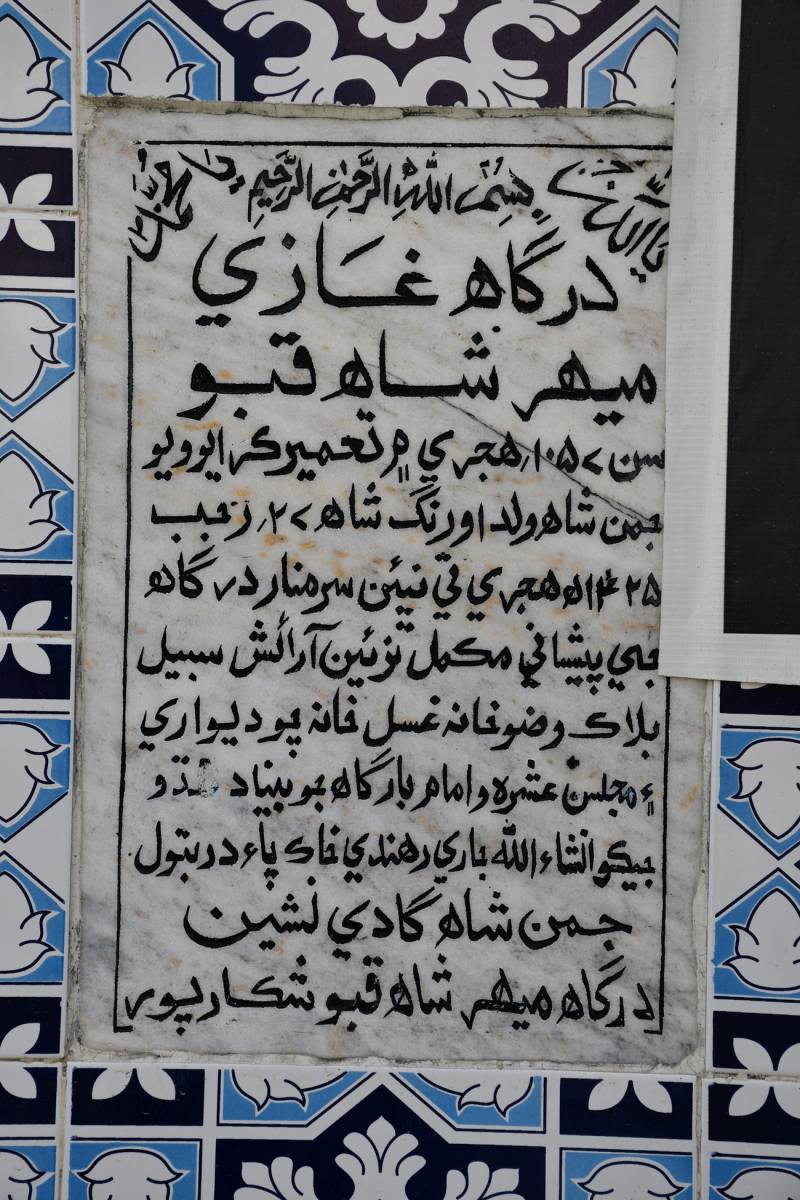
A Sindhi inscription on the wall of the main gateway reveals that the tomb was initially constructed in 1057 AH/1647 AD and subsequently underwent renovations. The inscription further indicates the provision of additional facilities and the establishment of the Imam Bargah by Juman Shah, the Gadi Nashin of Syed Mehar Shah Ghazi, on the 27th of Rajab, 1425/12 September 2004. Therefore, if the date of 1057 AH/1647 AD is accepted as accurate, this would position the tomb as the oldest in Shikarpur. However, the architecture contradicts the given information. In order to accurately assign a date to the tomb of Syed Mehar Shah Ghazi, it is essential to consider the defining architectural elements of tombs constructed in 17th-century Sindh. Notably, tombs from the 17th century typically do not exhibit turrets or corner kiosks; these features were first introduced during the Kalhora period (1700-1783). The presence of turrets that rise from the parapet of the tomb of Syed Mehar Shah Ghazi indicates that the tomb may have been built during either the Kalhora or Talpur period. I have visited all the historical tombs in the Shikarpur district, and I believe that no tombs from the 17th century still exist in any village or town in the area. Besides, I think the mosques from the 17th century have also been lost; they were demolished to construct new mosques.
All the tombs are noted for their square plan, with the hemispherical dome resting on the elevated polygonal drum, a feature that was noticeable in the tombs built during the last years of the Kalhora dynasty. The Talpurs continued this trend
The Haji Abdul Latif Shah Jilani Mosque, situated near Lakhidar, is thought to have been constructed in the second quarter of the 17th century. It is likely that the mosque was later rebuilt or renovated, which may have resulted in the loss of any original inscriptions that may have existed. The main arched entrance to the verandah of the mosque, which is a later addition, bears the date of the mosque's construction in 1026 AH /1617 AD. Even the word Gok, written above the mihrab of the mosque, from which the historian derives the date of the construction of the mosque, has also been rewritten later during the renovation. Nothing original exists in this mosque.
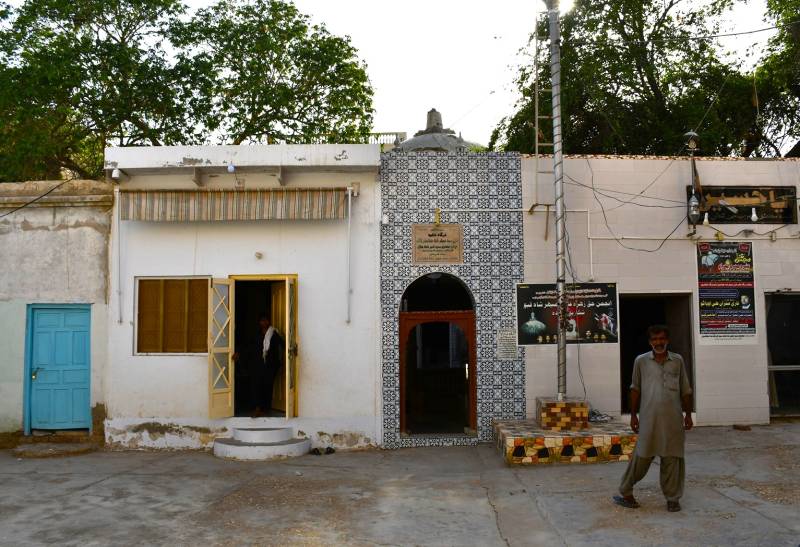
The most notable tombs in Shikarpur city were built during the 18th, 19th, and 20th centuries. One significant tomb is that of Haji Faqirullah Shah Alavi (d 1195/1781), an 18th-century Naqshbandi Sufi saint. This tomb was constructed in the last quarter of the 18th century and later renovated in 1337 AH/1919 AD, as indicated by the inscription on the tomb.
Apart from the tomb of Haji Faqirullah Shah Alavi, there are clusters of four tombs near Dakhan town, known as Bohi Quba, or the tombs of the Thaheem tribe. The Thaheem nobles died in a battle between the Sindhian and Afghan troops in 1193 AH/1779 AD. According to Henry Cousens (1998), the author of Antiquities of Sind, their wives later built their tombs in 1781 AD. These tombs are located between Dakhan and Ratodero in Garhi Yasin taluka. Three tombs belong to Thaheem nobles, two of them to Sahib Khan and Dilawar Khan, who died in the Kalhora-Afghan battle. The third tomb belongs to Jalal Khan Thaheem, which, according to Henry Cousens, is older than the two other tombs in the necropolis. Mahdi Shah (2005:283-284), an eminent historian of Shikarpur, writes in his book Abro Wad Waro that the tomb belongs to Jalal Khan Abro, not Jalal Khan Thaheem. These tombs have also been renovated.
All the tombs were adorned with corner kiosks and turrets. Most of the tombs have been renovated several times. All the tombs are noted for their square plan, with the hemispherical dome resting on the elevated polygonal drum, a feature that was noticeable in the tombs built during the last years of the Kalhora dynasty. The Talpurs continued this trend. Two tombs of Thaheem nobles were adorned with paintings, but much has been lost now.
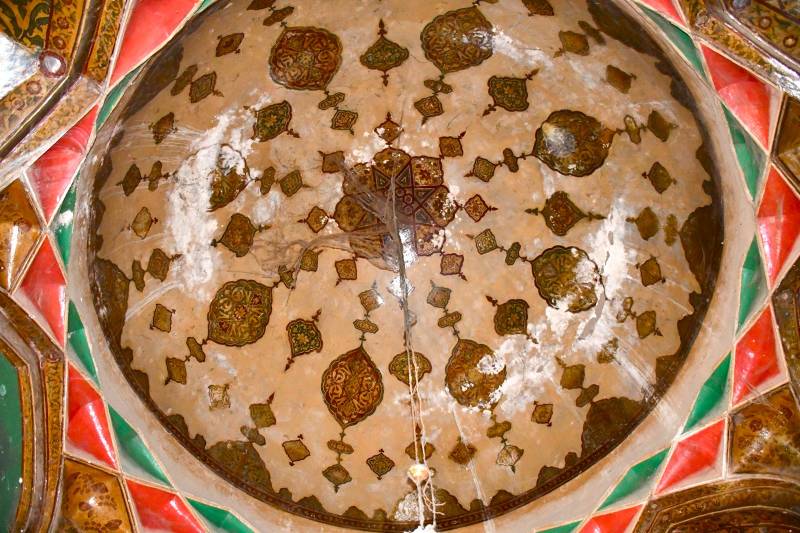
The tomb of Manochar Shah, popularly known as Manchar Shah in Shikarpur city, was contemporaneous with the tomb of Syed Mehar Shah Ghazi. Frequent renovations have also damaged the originality of the structure. What remains showcases the popular tomb architecture of the eighteenth century. The cemetery of Syed Manochar Shah is located on the Shikarpur Bypass. It also contains monuments which were mostly built in the eighteenth century, including the tomb of Manchar Shah, Rakhial Shah ( which has collapsed now) and the mosque of Rakhial Shah. On the western wall of the tomb of Manchar Shah is written either the date of his death or the construction of the tomb as 1147 AH/1734 AD.
Another historic tomb in Shikarpur belongs to Nawab Abdur Rahman Tariq Turrel, which is located in located near Dhak Bazaar in Shikarpur and is believed to have been built in the 19th century. Several tombs at Jami Ja Quba village and other villages in Shikarpur were built in the Talpur and British periods. One of the most splendid tombs belongs to Khwaja Pir Fida Mohiuddin Sarhandi, which is located in Pir Goth. This tomb was built in the British Raj. The tomb of Khwaja Pir Fida Mohiddin (d,1262 AH/1846 AD) was built by his son, Pir Muhammad Ashraf Jan Sarhandi (d 1878). The tomb of Khwaja Nizamuddin Sarhandi near Lakhidar was also built in the British period and was demolished recently, and built a new one was in its stead.
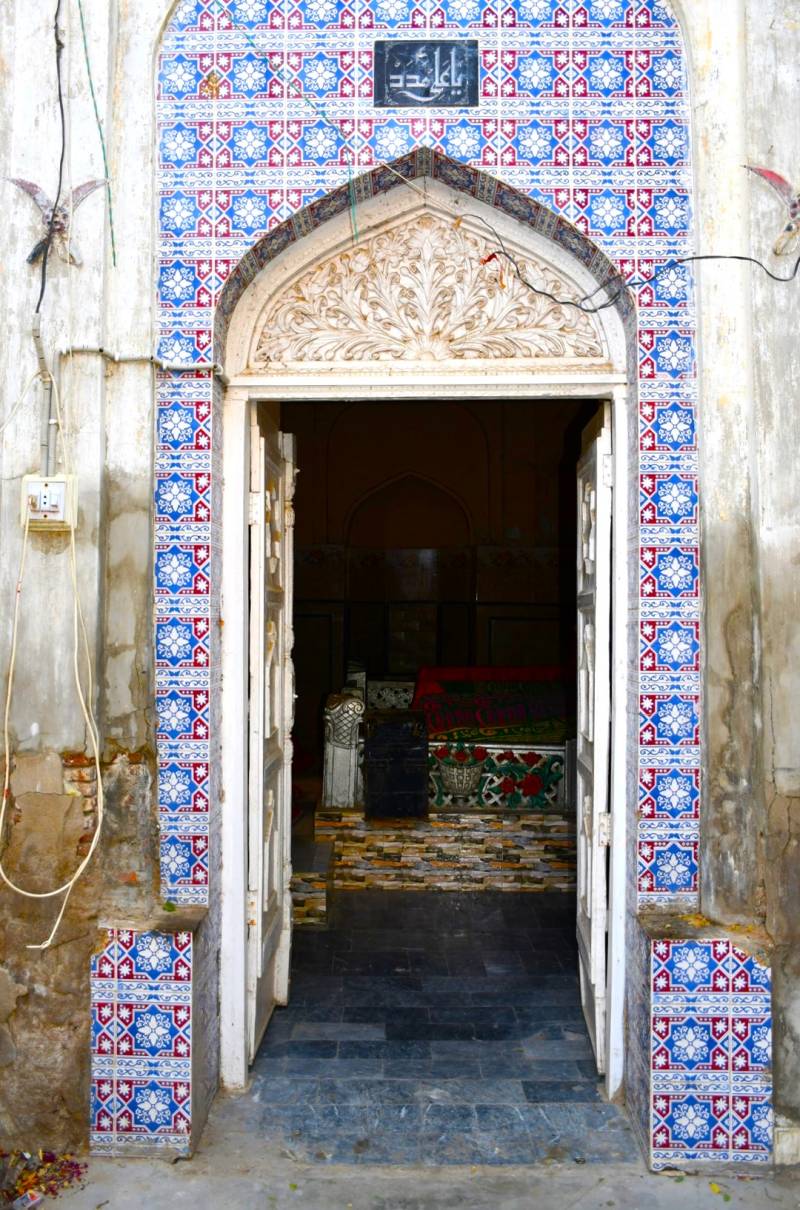
There are also two impressive tombs in Jami Ja Quba village, which belong to Suhrawardi Sufi saints Mian Muhammad Jami (d 1284 AH/1888AD) and Mian Fatehuddin. Both tombs were built during the British Raj. A few other tombs built during the British Raj in Shikarpur include the tomb of Budhal Faqir (d 1939), a Sufi poet, and Faqir Mian Taj Muhammad (d 1850), a Qadiri Sarwari Sufi saint. The tomb of Maulana Muhammad Yaqub (d 1273 AH / 1856 AD) and his son Maulana Abdul Ghafoor Humayuni (1333 AH / 1918 AD) at Humayun Sharif was known for its beautiful blue-glazed tiles and was constructed during the British Raj. The original tomb and mosque were demolished, and new structures were built in their place. Both father and son were celebrated scholars and Qadiri Sarwari Sufi saints of Sindh.
After a brief discussion about the tombs in Shikarpur, I will now focus on the tomb of Syed Mehar Shah Ghazi, which was built in the last quarter of the 18th century. The tomb was constructed using thin, red, burnt bricks. These bricks were commonly used during the Kalhora and Talpur periods. They continued to be used during the British period for several decades until thick red bricks replaced them. The tomb of Syed Mehar Shah Ghazi is constructed on a square plan and features a hemispherical dome topped with a partially broken finial, the base of which remains intact. The tomb exterior is characterised by two rows of false arches, which impart a double-storey appearance. The exterior is plastered, but some of the plaster has come off. The merlons that adorn the parapet of the tomb have also been crumbled. The thick red bricks were used to create merlons on the parapet of the tomb, reflecting that the tomb had also been renovated before the most recent repair that was carried out in 2004.
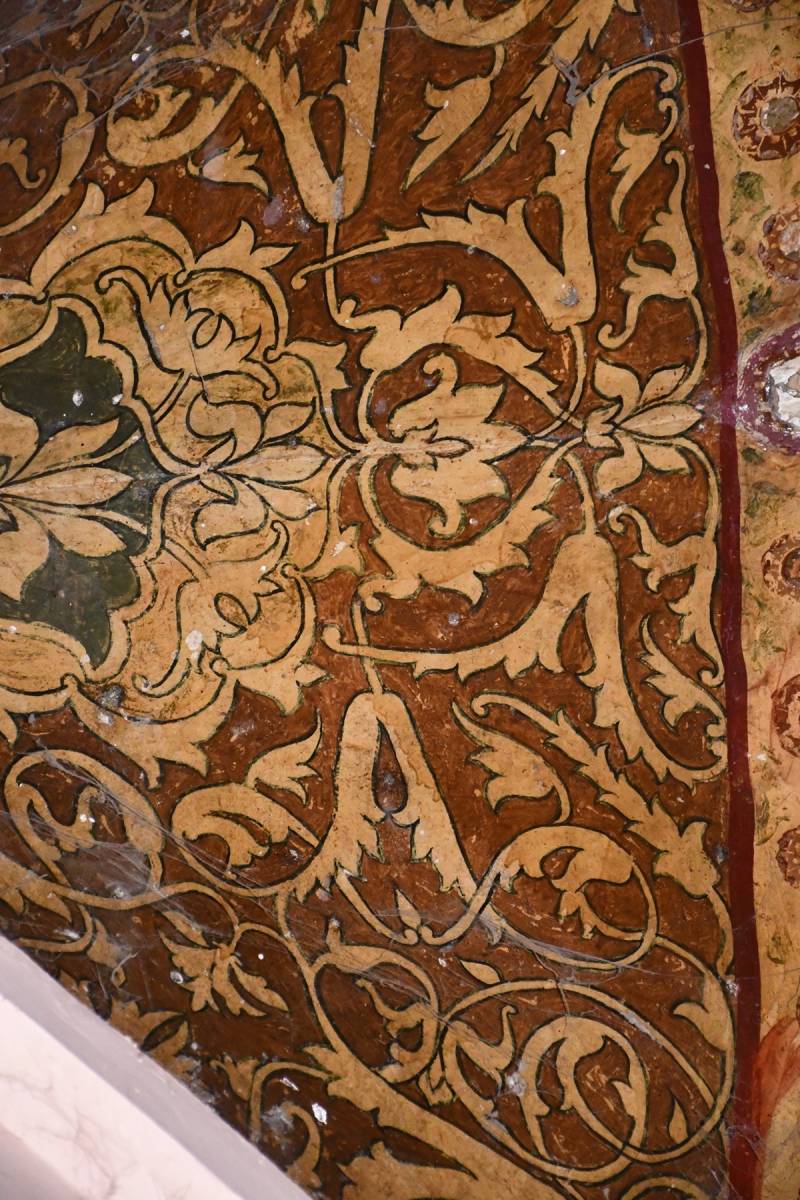
There are two doorways on the east and south of the tomb. The main eastern door is noted for wood carvings. Above the eastern door, the ceramics have been used recently during renovation in 2004. The interior of the tomb was decorated with sunken panels, which were made for ornamentation purposes. The tomb's interior was once beautifully painted, but renovations have damaged the artwork. Only the floral patterns on the domed ceiling and squinches remain, adorning the tomb of Syed Mehar Shah Ghazi.
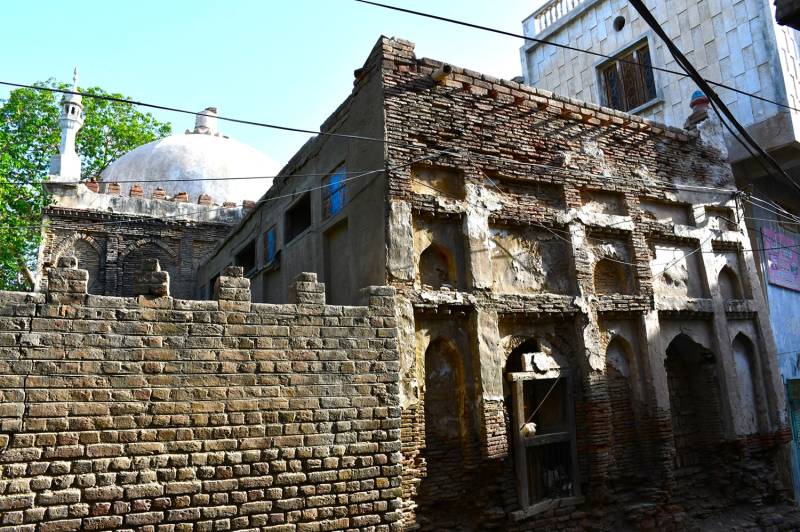
Adjacent to the tomb of Syed Mehar Shah Ghazi is an old mosque, which is believed to have been constructed by him. It was later rebuilt. The current abandoned mosque was likely built around the same time as Syed Mehar Shah Ghazi’s tomb, during the last quarter of the 18th century. Both structures were made using the same thin red bricks.
Over the years, the mosque has undergone several repairs, and its façade was adorned with glazed tiles, traces of which can still be observed today. Within the compound wall, there are several graves of Syed Mehar Shah Ghazi's descendants and disciples, while the interior of his tomb also contains the graves of his family members.

